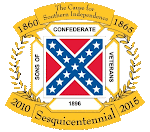Click on this link to see full article with pictures: http://www.euportal.cz/Articles/5339-confederate-flag-and-st-andrew-s-cross.aspx
Autor: David Dieteman
Publikováno: 30.11.2009
Rubrika: English
Joseph Stromberg rightly points out that the media prefers to refer to the St. Andrew's Cross on the Confederate battle flag as a letter X.
Of course, it is not a letter X. It is a cross – in particular, the St. Andrew's Cross. In vexillology (the study of flags), the technical term for such a cross is a saltire.
Webster's Third New International Dictionary (I don't have the OED on hand; sorry) defines a saltire as: noun, singular:
1.heraldry: an ordinary consisting of a cross formed by a bend dexter and a bend sinister crossing in the center of the field.
2.an X-shaped cross: esp. Saint Andrew's Cross.
The term derives from the Middle English and Middle French words for an X-shaped animal barricade that people could jump over. Presumably, the animals could jump over the middle of the X as well, but it never occurred to them to do so.
Webster's, by the way, provides an additional definition of a saltire: adj.: shaped like an X.
So perhaps there is nothing sinister going on in the mantra that the Confederate flag is an "X," but given that the mere reference to "an X" is an incomplete history of flags featuring the St. Andrew's Cross, and given the larger cultural climate of hatred of all things Christian, I smell a rat.
This is of particular concern to me, as I am a Roman Catholic and a parishioner at, well, wouldn't you know it – St. Andrew's.
In the church, there is a statue of St. Andrew himself, holding a big X in his hands. Why? He lived far too long ago to have been a Spike Lee fan or a follower of Malcolm X.
The reason he is holding the X is that it is not an X – it is a cross. Saint Andrew, you see, was crucified on an X-shaped cross.
The St. Andrew's Cross is not unique to the Confederate battle flag. The reason that the CSA put the St. Andrew's Cross on its flag is the Scottish heritage of the South.
The Scottish national flag, you see, is the St. Andrew's Cross in white on a field of blue.
(This is to be distinguished from the Scottish government flag, the flag of the Scottish monarchy, which features a red lion on a field of yellow.)
A similar situation to the Scottish situation is found in many nations, such as Germany, whose government flag has an eagle in the center of the red, black and gold banner, as does Austria (similar eagle issues).
Joseph Stromberg has brought to my attention the fact that, where the St. Andrew's Cross is concerned, in South Africa, the Transvaal (South African Republic, or ZAR) flag from 1874-75, known as the Burger flag, descended from the Voortrekker flag of 1836-40.
For those who do not read Afrikaans, Stromberg has provided a translation: "This [Burger flag] is a revised form of the Voortrekker flag. T. F. Burgers, as President of the South African Republic, tried to replace the Transvaal Vierkleur with this flag. From 1875, however, the Vierkleur was the official flag of the ZAR. The Burger flag was however sometimes hoisted next to the Vierkleur in Burgers's time, and was usually known as the President's flag."
(Much like those pesky Mississippians, the South Africans did not want a replacement flag.)
But back to St. Andrew and his cross.
Saint Andrew is also the patron saint of Russia. Unsurprisingly, then, the ensign of the Russian Imperial Navy which flew during the reign of the Czars, as well as the Russian Imperial Navy Jack both feature the St. Andrew's Cross.
And let's not forget the flags of Alabama and Florida.
A variant also appears on the Spanish Cross (the Cross of Burgundy, flown from 1516 to 1556 by Charles I of Spain), although I am not sure of any connection. However, since this flag was flown by Cortez in his conquest of Mexico, it is perhaps on the endangered banners list as well.
Given the recent media hysteria over Johnny Hart's "B.C." cartoon, and the general media ridicule of all things Christian, is it any wonder that the Confederate battle flag is hated?
The Confederate battle flag, by the way, is square.
The navy jack (or ensign, which was carried by some ground troups, as noted by AnyFlags.com) (right) is a rectangle.
The Left certainly hates the Confederate flag because it is "the flag of a stateless nation" that, despite its military surrender, has never surrendered its spirit.
Perhaps the Left also despises the St. Andrew's Cross because of Andrew's very name – it means "manly" in Greek. Post-modern, relativist western civilization simply cannot abide the concept of manliness.
April 21, 2001
Mr. Dieteman is an attorney in Erie, Pennsylvania, and a PhD candidate in philosophy at The Catholic University of America.
© 2001 David Dieteman
David Dieteman Archives
http://www.euportal.cz/Articles/5339-confederate-flag-and-st-andrew-s-cross.aspx
Subscribe to:
Post Comments (Atom)


No comments:
Post a Comment